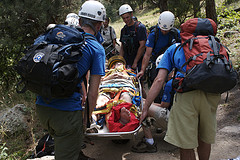4 Tips to Create a Simple, Effective Travel Medical Portfolio
20 April 2013
Even the most organized frequent travelers miss this step, but if you’ve ever experienced a medical emergency far from home, you know that things can quickly get out of control if you:
- Are in a traffic accident and unconscious (who will speak for you?)
- Have a pre-existing medical condition (even one controlled with medication)
- Suffer a new illness that strikes while on your trip (perhaps the bird flu?)
- Lose all your vital medications (what if that’s your heart medication?)
- Discover a new allergy while on your trip (bee sting perhaps?)
If you’re in a traffic accident, for example, you may not be able to speak for yourself, and just like having your In Case of Emergency (ICE) contacts in your cell phone back home, a travel medical portfolio can do at least some of the talking for you and help the medical care providers who are treating you.
What Goes in a Travel Medical Portfolio
A travel medical portfolio should contain the following for each person on the trip:
- Personal contacts to be notified in an emergency – think parents, siblings, work associates, anyone who needs to know that you’ve been hospitalized and are receiving medical care.
- Contact information for usual medical care providers – these are your primary care physicians who will have your full medical history on hand and can answer questions those treating you may have.
- Current medical conditions – many medical conditions are not obvious and knowing the conditions you currently have will help those treating you know what to do and whether you’re perhaps suffering from a new condition or a side effect of an existing medical condition.
- Current medications, including dosages and schedule – because some medications react with others and some cause changes when you’re traveling, knowing what you’re taking now is critical information for those who are currently treating your travel medical emergency.
- Basic medical history – date of birth, allergies, blood type, etc. This should include your vaccination history as well as any special or recent vaccinations necessary for the trip you’re currently taking.
- Any recent surgeries or illnesses – these facts will have a direct affect on your immediate treatment.
- Your travel itinerary – this one sounds a little odd, but if you recently visited one country and have continued on to another, you may have contracted something in the first place you visited and having that information will help your emergency medical team.
- Travel medical insurance information – your travel insurance provider will need to be notified in case they need to arrange to have someone from back home flown to your bedside or they need to arrange payment for your emergency medical care.
- If you are, or suspect you may be, pregnant put that at the top of the medical information because this is very important information for those treating you to know immediately.
Don’t let the term portfolio scare you away. While the list above looks like a lot of information it really isn’t a lot and your travel medical portfolio doesn’t have to be a complicated thing with pockets and tabs after all.
Here are 4 tips to make a simple, effective travel medical portfolio.
1. Make Managing your Travel Medical Portfolio Easy
Every year, you’ll likely have at least a few changes to your medical information. If you move, change doctors, switch medications, discover new allergies, those changes need to be made to your travel medical portfolio. So it’s important to make managing your travel medical portfolio easy.
We recommend keeping your travel medical information in a simple document on your computer which you can update, save to your mobile devices, and print when it’s time to leave for a trip.
2. Update your Travel Medical Portfolio with Every Trip
It’s important to recognize that every trip is different, so what goes in your travel medical portfolio for one trip may be very different than what goes in for another. For example, on one trip, you may take the kids and you’ll need their medical information in addition to your own.
If you’re traveling to a location where you need particular vaccines, you’ll want to note that you received those (along with the dates and doctor’s contact information) in your travel medical portfolio.
3. Keep your Travel Medical Portfolio Small and Handy
Ideally, all this information will fit easily onto a note card, which can be placed in your wallet, in your money belt, and in your suitcase. You’ll want to keep this information safe with your other important travel documents, like the copy of your passport identification page.
4. Share your Travel Medical Portfolio
If you’re traveling with another person, trade a copy of your portfolio with the other person. If they’re unconscious, you’ll want that medical information handy so you can speak for them; likewise if you’re the one who needs support.
If you’re traveling alone, leave a copy with a family member, friend, or business associate back home and make sure their contact information is easily available on your person. If you can’t do the talking, they will be able to get their hands on the medical information and do the talking for you.
Damian Tysdal is the founder of CoverTrip, and is a licensed agent for travel insurance (MA 1883287). He believes travel insurance should be easier to understand, and started the first travel insurance blog in 2006.

